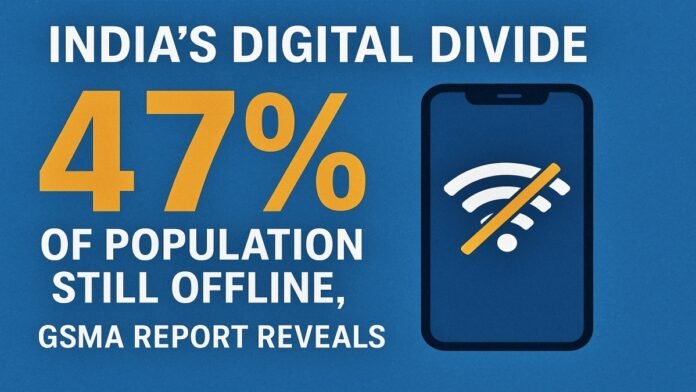
Key Points
- Significant Offline Population: Nearly half of India’s population (47%) remains without internet access, according to a new GSMA report released at India Mobile Congress 2025.
- Major Gender Gap: Women are 33% less likely than men to use mobile internet, a disparity driven by high handset costs and a lack of digital literacy.
- Surging Digital Economy: Despite the connectivity gap, India’s digital economy tripled from $108 billion in 2013 to $370 billion in 2023 and is projected to exceed $1 trillion by 2030.
- Innovation is the ‘Achilles’ Heel’: While India excels in Digital Public Infrastructure (DPI) and 5G rollout, it lags in R&D investment, private sector innovation, and talent retention.
- ‘Brain Drain’ Risk: The report warns that without urgent action, India risks a “brain drain dividend” that benefits global competitors instead of fueling domestic growth.
- Internet Users: As of early 2025, India had 806 million internet users, representing a penetration rate of 55.3%, meaning 652 million people remained offline at the start of the year.
New Delhi: Despite a decade of rapid growth under the “Digital India” initiative, nearly half of the country’s population remains disconnected from the digital world. A landmark report, “Towards Digital Sovereignty in India,” released by the Global System for Mobile Communications Association (GSMA) at the India Mobile Congress 2025, reveals that a staggering 47% of Indians are still offline. This persistent connectivity gap, particularly affecting women and rural communities, threatens to undermine the nation’s goal of achieving inclusive growth and digital sovereignty by 2047.
The Stark Digital Gender Divide
A critical issue highlighted in the report is the entrenched digital gender gap. Women in India are 33% less likely than men to use mobile internet, a disparity that could significantly hold back inclusive economic growth if not urgently addressed. Julian Gorman, Head of Asia Pacific at GSMA, identified the high price of mobile handsets and a lack of technical skills as the primary barriers preventing wider adoption among women and rural populations. This gap means millions of women are excluded from the social and economic benefits of the digital revolution, from education and healthcare to financial inclusion and employment opportunities.
A Booming Digital Economy with a Widening Chasm
The report presents a paradox: India’s digital economy has experienced explosive growth, surging threefold from $108 billion in 2013 to $370 billion in 2023. This digital sector now represents 11.7% of the country’s gross value added and is on a trajectory to surpass the $1 trillion mark by 2030. The nation is a world leader in developing Digital Public Infrastructure (DPI) and executing a rapid 5G rollout, with median mobile download speeds increasing by 6.5% to reach 100.78 Mbps in the past year.
However, this impressive economic momentum is built on a foundation with significant cracks. The GSMA warns that this progress could falter unless critical gaps in innovation and adoption are closed. “India has become a digital powerhouse over the past decade… But to sustain this momentum, India must focus on innovation… and ensure every citizen, especially women and rural communities, can benefit,” stated Vivek Badrinath, Director General at the GSMA.
Innovation: The Nation’s ‘Achilles’ Heel’
While India has excelled in digital infrastructure, the GSMA report identifies innovation as its “Achilles’ heel.” The country lags behind its Asia Pacific peers in several crucial areas that are vital for long-term, sustainable digital growth.
- Low R&D Investment: Insufficient investment in research and development is stifling the creation of homegrown technologies and solutions.
- Sluggish Private Sector Innovation: The pace of innovation within the private sector is not keeping up with global standards, which could limit India’s competitiveness.
- Talent Retention (‘Brain Drain’): A significant challenge is the “brain drain” of skilled professionals. The report warns that without urgent action to retain top talent, India risks a “brain drain dividend” where its highly skilled workforce fuels the growth of global competitors instead of its own domestic economy.
The Path to Digital Sovereignty
To ensure the benefits of the digital economy are shared by all and to achieve its 2047 digital sovereignty goals, the GSMA report outlines four urgent priorities for India:
- Accelerate Collaboration: Foster deeper partnerships between government, industry, and civil society to combat fraud, close the usage gap, and scale up innovation.
- Unlock Investment: Implement supportive policies to encourage greater private investment in critical infrastructure like fibre networks, data centers, and R&D facilities.
- Maintain Global Cooperation: Leverage India’s leadership role in the Global South to expand technology exports and influence global standards.
- Strengthen Institutions: Prepare regulatory and governance frameworks for the next wave of transformative technologies, including AI, 6G, blockchain, and quantum computing.
Ultimately, the report serves as a crucial call to action. While celebrating India’s remarkable digital progress, it underscores that true digital sovereignty can only be achieved when no one is left behind in the digital journey.






































